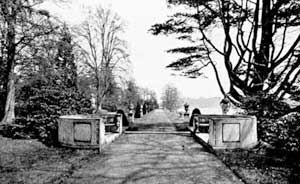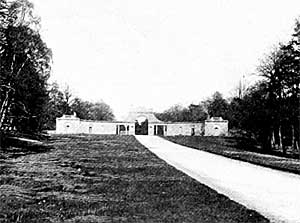
NAPOLEON BY CANOVA.
We are now back again in the Hall, the principal pictures in which are a landscape by Gainsborough, "The Return from Shooting," by Wheatley, "Southwark Fair," by Hogarth, and a Vander Neer. In the Gallery upstairs are a Battista Franco, a Holbein, several Rubens, a Ruysdael, a Lawrence, besides many more. There are also some rather fine antiques purchased by the fourth Duke at Nollekin's sale, including four white marble Cists, dating from the first century; nor must we forget Canova's colossal statue of Napoleon.
Having exhausted the house we will go on to the Chapel, which stands about three hundred yards away on the east of the Pleasure Grounds, and was built by the present Duke and opened in 1889. The style is fourteenth century gothic, and it has a warm and old appearance, being constructed in red sandstone. On entering, the effect is that of a genuine fourteenth century Chapel untouched by the devastating hand of the so-called Reformation. The altar is of beautiful white alabaster, standing out from the green silken hangings, which are some day to be replaced by something more solid. The carvings all over the Chapel are very fine, particularly in the Lady Chapel, where the side altar, like the rest of the Church, is carved in red sand-stone, the subject of the Reredos being "The Annunciation." From the roof gleams the Magnificat in letters of gold, and the sun shines in with softened rays through the beautiful windows designed and executed by Kemp.

The Lincoln Terrace, Clumber.
The Lincoln Terrace, about a quarter of a mile from the Italian Garden, is also worth a visit, with its fine old stately seats, and steps down to the water. It was made early in the last century with stone brought from Italy at the cost of £10,000.
The trees that flourish best at Clumber are cedars — there are many fine ones near the house; Scotch firs, birches, and limes also do well; in fact an avenue of the latter, two and a half miles long, and ending with Apleyhead Lodge, is one of the features of the Park. In the middle of the avenue (at Hardwick) are the Kennels and the Farm; and those interested in animals will find plenty there to admire in things canine. Some six brace of the old breed of Clumber spaniels, introduced from the north of Spain by a former Duke, at the end of the eighteenth century, still disport themselves. They are very difficult animals to breed, I presume from having for many years been much inbred. Dogs have always been favourites at Clumber, but never more so than they are at present, for I suppose I may confess that they and horses are my mania. I have some fifty Borzois or Russian wolf hounds; many of them well known on the show bench, for they have, since 1892, won over five hundred prizes at all the principal shows in England. Beautiful dogs they are, and most affectionate, intelligent companions. Fox terriers, too, are here, and they also have won their laurels ; very proud I am that the highest honours have been won by many of Clumber breeding, for it is more difficult to win with fox terriers, than with any other breed. Added to the Borzois, fox terriers, and Clumber spaniels, I must also mention the pack of harriers, eighteen couples in all, of twenty-one inch hounds of the foxhound type. And very good sport we have with them, too, during the winter. They are a very good-looking pack, as may be inferred when I add that they have won on several occasions at the Peterborough Hound Show, including the cup for the best "three couples."

Apleyhead Lodge.
And now I should like to add that I have practically rewritten this article since its previous appearance in the Pall Mall Magazine.
Before the paper was sent to the Magazine some additional matter was interpolated without my knowledge or sanction, and without the knowledge or sanction of the Editor. To this additional matter (on seeing it in print and being in no way answerable for it) I much regret that my signature should have been appended.
(Signed) K. Newcastle.
